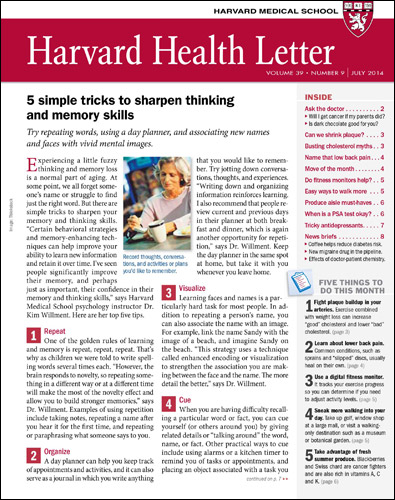Harvard Health Blog
Decline in colorectal cancer in U.S. tied to wider use of testing

Some good news on the cancer front: between 2000 and 2010, rates of colorectal cancer in American adults fell by about one-third. That decline mirrored a sharp rise in colorectal cancer testing during the same period.
American Cancer Society researchers found that the drop in colorectal cancer rates was highest among Americans aged 65 years and older. Cases fell 3.6% a year from 2001 to 2008, then dropped even more by 7.2% a year from 2008 to 2010. But the researchers saw a troubling trend in younger adults: an increase in colorectal cancer of 1.1% a year among people under age 50. Rising obesity rates may be to blame. Their report appeared in the March/April issue of CA: A Cancer Journal of Clinicians.
The researchers attribute the decline in colorectal cancer to early testing for the disease. There are other contributors, too, including the continued decline in the number of smokers in the U.S. (colorectal cancer has joined the list of many other cancers caused by tobacco use) and widespread use of daily aspirin and other nonsteroidal anti-inflammatory drugs (NSAIDs), which appear to decrease the risk of colorectal cancer in some people.
Despite the optimistic findings, colorectal cancer is still a scourge. In the U.S. this year, an estimated 72,000 men and 65,000 women will be diagnosed with colorectal cancer; 26,000 men and 24,000 women will die of it.
Testing for colorectal cancer
There are several ways to detect small, precancerous growths called polyps and early stage cancers before they spread from the colon to other parts of the body:
- Colonoscopy. This is considered to be the best test. A doctor inspects the entire rectum and colon using a flexible tube with a light and camera at its tip. If a cancerous or precancerous growth is seen, it can be removed. Some people don't like this test because it requires cleaning out the bowel beforehand. It also requires sedation, meaning someone needs to drive you home from the test.
- Sigmoidoscopy. This is similar to a colonoscopy, but only the last portion of the colon is inspected. You don't need someone to drive you home.
- Stool testing. This is the easiest but least effective test. A sample of stool is tested for tiny amounts of blood. Blood may indicate the presence of colon cancer. You do this at home and send it in.
Two other screening tests are available, but are not covered by Medicare or most other health insurance:
- Virtual colonoscopy. This special type of CT scan is less invasive than regular colonoscopy. But you still need to clean out the bowel beforehand. And if the scan finds a polyp or other growth, you will need a regular colonoscopy to have it removed.
- DNA stool testing. This is another type of stool test. It checks for the DNA associated with cancer cells. A study in this week's New England Journal of Medicine showed that a new type of DNA stool test detects more than 90% of colorectal cancers. But again, if the test indicates the presence of cancer, you will still need a regular colonoscopy.
Looking ahead
Despite the progress, we can prevent many more deaths from colorectal cancer. Not everyone has access to screening and treatment because of social and economic factors. By providing access to all adults over age 50 and younger people at higher than average risk, some experts predict that death from the disease could be cut in half by 2020.
Disclaimer:
As a service to our readers, Harvard Health Publishing provides access to our library of archived content. Please note the date of last review or update on all articles.
No content on this site, regardless of date, should ever be used as a substitute for direct medical advice from your doctor or other qualified clinician.
















